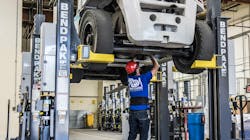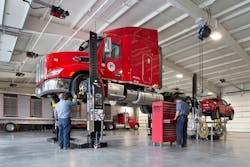If you spend any time in a truck maintenance facility, the hazards that technicians face are quickly obvious. There are heavy parts that must be maneuvered into place requiring bending, stretching and twisting. It’s equally easy to see back and muscle pain, fatigue and injuries happen.
There’s also often the need during truck and trailer service operations to reach into tight places. This can lead to skinned knuckles, bruises and cuts for technicians. Those activities might need to be performed when the vehicle is hot or running, so you can add burns to the list as well.
Last but not least, parts being removed can often be greasy or slippery. That not only makes them harder to grasp securely; losing your grip can cause injuries to your hands. Drop a heavy part, and you risk injury to your feet or toes.
High stakes
Jeff Kritzer, executive vice president at BendPak, citing OSHA stats, noted that work-related musculoskeletal disorders (MSDs) are among the most frequently reported causes of lost or restricted work time. He added that the Bureau of Labor Statistics found these disorders accounted for 30% of all worker injury and illness cases in 2018, representing almost 272,780 injuries per year. This is a 12% from 2011, indicating a stronger emphasis on preventing MSDs over the last decade is working.
Several manufacturers, from Ford to Toyota, have assembly workers donning exoskeletons to relieve the muscular wear and tear, allowing workers to come home less sore and able to enjoy their off time. Those workers can repeat tasks thousands of times a day, requiring such a preventive measure. Maintenance workers, by comparison, suffer about a one-sixth of the MSDs, according to BLS data, with 6,010 cases in 2018, and most wouldn't require such a sophisticated solution as an exoskeleton. But shops should have some plan of attack, as one MSD injury can sideline a technicians for weeks to months, affecting older workers more frequently.
OSHA advised "a strong commitment by management is critical to the overall success of an ergonomic process," such as through encouraging workers to go through training and report early symptoms of an MSD.
That’s why Rush Enterprises makes the health and safety of employees a top priority, noted Victor Cummings, vice president of service operations. “We focus heavily on training and prevention of injuries that could be caused by lifting, bending, stooping, pushing, pulling, twisting or carrying heavy items,” he said. “Our robust training platform provides job-specific training, assigned by title and responsibilities, and training is part of the onboarding process.”
Rush Enterprises also deploys a wide range of engineered controls and personal protective equipment to mitigate the risk associated with moving heavy items. Those include cranes, hoists, push carts, two-handed dollies, pallet jacks, forklifts, jacks and jack stands. Additionally, the company has policies, procedures and job aids on how and when to use these items, when and how to manually lift, and how to maintain lifting aids and remove them from service if they are defective.
“The company also sends routine risk-based communications to its shop employees regarding safe lifting practices and application of lifting aids,” Cummings added. “Safe lifting is also addressed in monthly safety department meetings and dealership safety committee meetings.”
Lifts and safety
“Vehicle lifts let technicians use tools that literally take the weight off their backs,” said R.W. “Bob” O’Gorman, president, Automotive Lift Institute (ALI). “For example, they can use transmission jacks, lift tables and other equipment to support heavy components during removal and installation, instead of trying to physically move them.”
Standing with the vehicle at a comfortable working height is more ergonomic, resulting in less strain on the technician’s body and less chance of injury, Kritzer stated. “Over time, consistently working in ways that are not ergonomic can lead to musculoskeletal disorders– injuries to muscles, joints, tendons, ligaments, and nerves,” he said. “Common musculoskeletal disorders caused by overexertion, repetitive motion and other on-the-job triggers include herniated discs, meniscus tears, sprains, strains and hernias.”Kritzer added that raising a vehicle on a lift also provides better access to under-vehicle components so the technician doesn’t have to twist and strain to remove and install them. It also provides more light in the work area and makes it easier for the technician to bring in additional lighting to service vehicles more efficiently.
Doug Spiller, director of heavy-duty product management for Rotary Lift, pointed out that lifts can help ensure the well-being of technicians in a variety of ways. “Well-trained technicians tend to work more safely,” he related. “By providing convenient, comfortable access to every part of a vehicle that needs service, technicians are less likely to encounter accidents or suffer injuries.
“In an industry that is no stranger to the growing shortage of technicians, making investments in top-quality shop equipment like vehicle lifts can show that you value your employees and their safety,” Spiller continued. “Lifts not only improve ergonomics and safety, they also improve employee recruitment and retention.”
Peter Bowers, technical sales manager at Stertil-Koni USA, agreed.
“Lifts make for a safer, more ergonomic, and pleasant work environment for technicians,” he stated. “By offering direct, comfortable access to the vehicle, your technicians are able to work more efficiently and with reduced concern for workplace injuries, notably back strain. And in today’s competitive employment environment, a shop with lifts is able to attract and retain top-performing technicians.”
At Rush Enterprises, taking employee health seriously is seen as a means of retaining technicians. “With roles that can be very physically demanding, safety may be the most critical component to employee retention,” Cummings said. “Technician retention is directly related to the culture of safety we create and foster in our dealerships.”
About the Author

Seth Skydel
Seth Skydel, a veteran industry editor, has more than 36 years of experience in fleet management, trucking, and transportation and logistics publications. Today, in editorial and marketing roles, he writes about fleet, service, and transportation management, vehicle and information technology, and industry trends and issues.

